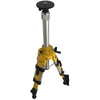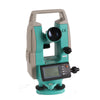Automatic Level Doubles Measurement Efficiency, Becoming a "Must-Have Artifact" for Engineers

In the world of precision engineering and construction, the automatic level has emerged as a game-changing tool, revolutionizing how surveyors and engineers conduct measurements. Unlike traditional optical levels, an automatic level uses an internal compensator to automatically maintain a level line of sight, eliminating manual adjustments and significantly reducing human error. With its high accuracy, efficiency, and ease of use, this instrument has quickly become indispensable in modern surveying and construction projects.
Why the Automatic Level is a "Must-Have Artifact" for Engineers
1. Unmatched Precision and Accuracy
The automatic level surveying instrument is designed to deliver millimeter-level accuracy, ensuring reliable data for critical engineering projects. Its self-leveling mechanism compensates for minor tilts, guaranteeing consistent results even on uneven terrain.
2. Doubled Measurement Efficiency
Traditional leveling requires constant manual adjustment, but an automatic level eliminates this step, allowing engineers to focus solely on readings. This cuts measurement time by half, boosting productivity on large-scale projects.
3. User-Friendly Operation
With intuitive designs and minimal setup requirements, even beginners can operate an automatic level with minimal training. Features like quick-focus eyepieces and bright, clear optics enhance usability in various lighting conditions.

4. Durability for Harsh Environments
Engineers often work in challenging conditions, from dusty construction sites to wet outdoor environments. High-quality automatic levels are built with rugged, waterproof casings and shock-resistant components to withstand tough job sites.
5. Cost-Effective Long-Term Investment
While the initial cost may be higher than manual levels, the automatic level pays for itself by reducing labor hours, minimizing rework due to errors, and extending service life with robust construction.
Key Applications of Automatic Levels
The versatility of automatic level surveying instruments makes them essential across multiple industries:
Construction & Civil Engineering – Used for site leveling, foundation setting, and road grading.
Land Surveying – Ensures precise elevation measurements for topographic mapping.
Mining & Tunneling – Helps maintain alignment and slope accuracy in underground projects.
Agriculture – Assists in land grading and irrigation system planning.
Infrastructure Development – Critical for bridges, railways, and large-scale urban projects.

What to Consider When Choosing an Automatic Level
1. Measurement Accuracy
Look for models with ±1.5mm/km or better accuracy for professional-grade results.
2. Magnification & Clarity
Higher magnification (e.g., 32x) ensures better visibility over long distances.
3. Self-Leveling Range
A wider self-leveling range (e.g., ±15’) allows for faster setup on uneven ground.
4. Durability & Weather Resistance
Opt for waterproof (IPX6+) and dustproof designs for reliability in harsh conditions.
5. Brand Reputation & After-Sales Support
Choose established manufacturers like Mountlaser, which offers technical support and warranty coverage.
Conclusion
The automatic level has transformed modern surveying by delivering unmatched speed, precision, and ease of use. Its ability to double measurement efficiency while reducing errors makes it an essential tool for engineers across construction, mining, agriculture, and infrastructure development.
When selecting an automatic level surveying instrument, prioritize accuracy, durability, and manufacturer reliability. Mountlaser provides a variety of high-performance models to suit different project demands.
Ready to upgrade your surveying equipment? Contact Mountlaser today to explore our range of automatic levels and find the perfect fit for your needs!





